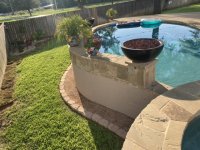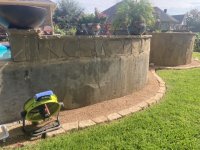I have a raised wall about 4 ft high and I chose to not have flagstone on the backside of it because you can't see it (and I saved about $3,000). I assume I can paint it or stain it with anything I want but I was curious if there is something specific I should do to seal it or protect it. Right now it's just exposed gunite which had my yard not been on such a slope would be covered with dirt so I figure there's no real harm being done as its exposed. Curious if anyone has ideas
Painting / Staining backside of gunite wall
- Thread starter 6XSBChamps
- Start date
You are using an out of date browser. It may not display this or other websites correctly.
You should upgrade or use an alternative browser.
You should upgrade or use an alternative browser.
I would recommend elastomeric paint. it is similar to that used to paint stucco or masonry surfaces. Also best if you use a high quality acrylic primer prior to painting a specific color.
- May 23, 2015
- 24,486
- Pool Size
- 16000
- Surface
- Plaster
- Chlorine
- Salt Water Generator
- SWG Type
- Pentair Intellichlor IC-60
Lots of harm if you don’t finish it. Gunite is not waterproof and so the rebar that’s embedded in it can rust due to water absorption. Also, from constant exposure to water and possible freeze/thaw cycling, it can crack and spall more easily.
The gunite needs a water barrier material first (Ex., HydroBan by Laticete) and then a covering material. I would suggest you use colored plaster. Plaster is water proof and will last A LOT longer than paint.
The gunite needs a water barrier material first (Ex., HydroBan by Laticete) and then a covering material. I would suggest you use colored plaster. Plaster is water proof and will last A LOT longer than paint.
Turbo1Ton
Gold Supporter
- Dec 26, 2019
- 1,840
- Pool Size
- 14500
- Surface
- Plaster
- Chlorine
- Salt Water Generator
- SWG Type
- Pentair Intellichlor IC-40
I've seen this comment a few times in the past several weeks, when discussing raised walls. How is this different than a gunite shell that is surrounded by soil? Wouldn't that gunite also absorb moisture and cause the rebar to rust? Or is it just a case of that is part of it, since it is not accessible to finish?Lots of harm if you don’t finish it. Gunite is not waterproof and so the rebar that’s embedded in it can rust due to water absorption.
--Jeff
- May 23, 2015
- 24,486
- Pool Size
- 16000
- Surface
- Plaster
- Chlorine
- Salt Water Generator
- SWG Type
- Pentair Intellichlor IC-60
I've seen this comment a few times in the past several weeks, when discussing raised walls. How is this different than a gunite shell that is surrounded by soil? Wouldn't that gunite also absorb moisture and cause the rebar to rust? Or is it just a case of that is part of it, since it is not accessible to finish?
--Jeff
Soil moisture and mineral content tends to be very stable over time (once you get down a few inches). Rain water and condensation are very corrosive since they contain no mineralization whatsoever. So atmospheric moisture on a bare gunite surface will draw out minerals (calcium). Chloride is much more likely to get introduced from external sources than through the ground (soils are mostly chloride deficient) and chloride attack is the primary driver of rebar corrosion.
The purpose of sealing gunite is to protect it with a layer of material that is easily repaired. Just as you shingle and paint or plaster a home to protect the underlying wood frame, you need to protect the gunite shell which is your primary structural body. Once the gunite shell starts to get damaged, repairs become much more complex, difficult and expensive.
Turbo1Ton
Gold Supporter
- Dec 26, 2019
- 1,840
- Pool Size
- 14500
- Surface
- Plaster
- Chlorine
- Salt Water Generator
- SWG Type
- Pentair Intellichlor IC-40
We stuccoed ours it was very economical compared to putting on a stone veneer.
If I were to plaster would I need the water barrier since plaster is waterproof?The gunite needs a water barrier material first (Ex., HydroBan by Laticete) and then a covering material. I would suggest you use colored plaster. Plaster is water proof and will last A LOT longer than paint.
- May 23, 2015
- 24,486
- Pool Size
- 16000
- Surface
- Plaster
- Chlorine
- Salt Water Generator
- SWG Type
- Pentair Intellichlor IC-60
If I were to plaster would I need the water barrier since plaster is waterproof?
There is no higher authority than Kirk G -
I would suggest you use a bonding agent on any vertical surface that is going to get stucco. Clean and prep the surface very well, use a bonding agent and the add the plaster stucco.
Thread Status
Hello , This thread has been inactive for over 60 days. New postings here are unlikely to be seen or responded to by other members. For better visibility, consider Starting A New Thread.



